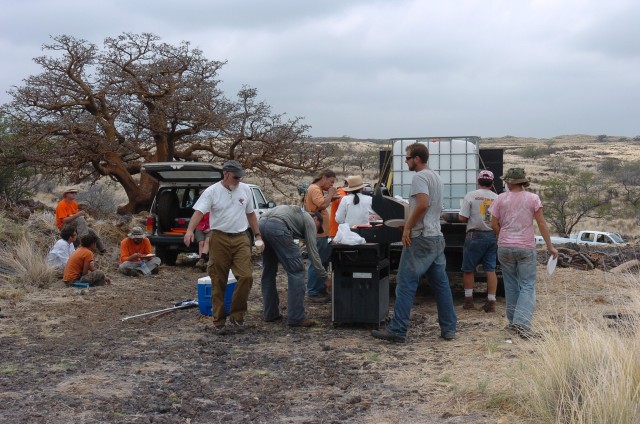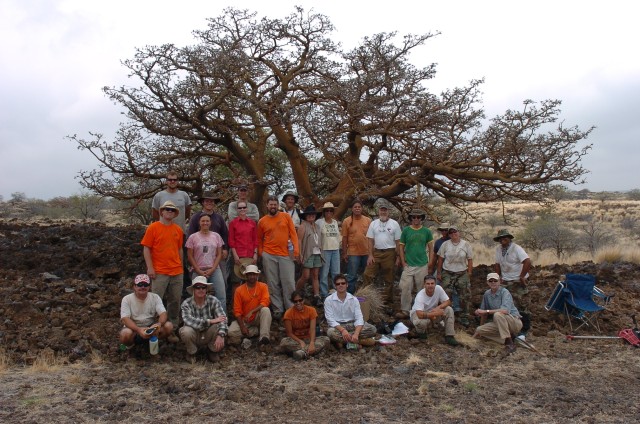<p>POHAKULOA TRAINING AREA, Hawaii - Satisfaction is the end word for this all-volunteer force trying to protect Big Island land against forest fires and feral goats living in the area.</p><p>Civilian employees at the Pohakuloa Training Area (PTA), led by Robert Wright, deputy garrison commander, joined forces with members of the Waikoloa Dry Forest Recovery Project Group, to remove invasive weeds. The 24-member group cut fountain grass and other invasive weeds as a preventative measure against wildland fires and placed fences in designated areas to prevent wild goats and other animals from ravaging native vegetation near the Waikoloa Village on the Big Island. </p><p> "We have biologists, folks from the conservation department, guys who work at Pohakuloa, and even another person who has a doctorate degree," said Dave Faucette, land rehabilitation and management coordinator, PTA Integrated Training Area Management (ITAM). "We really have people from all walks of life who wanted to contribute and help out." </p><p>One volunteer was eager to get rid of the invasive vegetation. </p><p> "I recently retired from the Department of Culture and Natural Conservation Services and wanted to do something to keep me busy," said Jerry Williams, a project volunteer. "So far, we worked on some fire breaks to reduce potential fire hazards and wildfires. This area has some particularly rare trees, the uhiuhi and the wiliwili that need protection. The trees are surrounded by fountain grass, which is considered a hazard to the trees, and so we are using weed eaters to cut the grass." </p><p>Volunteer labor generates grant money for the group. </p><p> "The project has been sponsored by money from NRCS (Natural Resources and Conservation Services) and from the Forest Station," Faucette said. "What happens is, we sign our names on a roster sheet and give the form to NRCS personnel and calculate how much in-kind service we provide. In return, we receive a grant. The dry forest recovery group can use this grant money to put in irrigation and be able to purchase more materials that we can use to do all kinds of things." </p><p>The number of volunteers is sometimes overwhelming. </p><p> "We are grateful that Dave (Faucette) came along with some volunteers from Pohakuloa to do some grass clearing," said Beverley Brand, coordinator, Waikoloa Dry Forest Recovery Project, and president, Waikoloa Village Outdoor Circle. </p><p> Brand said her group wanted this project to be a community-based project now that it has had legal access to the area for a couple of years. </p><p> "We plan to put a fence around these trees. Once we've got that done, we can quarantine the thirty-five dry forest species, then plant seedlings, and have a greenhouse and water (irrigation)," Brand added. "Part of the recovery project is also to create a trail for people to enjoy the area. We are also hoping helicopters can use the firebreaks for defense in firefighting and make it a dual purpose." </p><p>The group sees the project as a long-term, lifelong mission. </p><p> "Because we have endangered trees in the area, this might be our last chance of saving these endangered plant species," Brand said. "We have thirteen trees left and are trying to create an environment for them so that the seeds will eventually regenerate through the natural process of the blowing wind. We will care for them and water them. Our vision is, maybe in a hundred years, this whole seventy-five acres will be an example of the naturally regenerated environment." </p><p>According to Brand, the project started when someone in the village sold some of the wiliwili trees to a resort hotel. </p><p> "When members of the Waikoloa Village Outdoor Circle found out, they thought that was not appropriate," said Brand. "We went to the village association and told them that we need to do something about this (transfer of native trees from the area). We asked the village board of directors that these trees, the uhiuhi, and the wiliwili with thirteen left in the entire world, should be protected." </p><p>One PTA volunteer agreed. </p><p> "These trees are the last in the world, and it is gratifying to know that we are taking steps in preserving these natural resources," Chris Hardenbrook, geographic information systems analyst, PTA ITAM, said.</p>
Goats, fire endanger Waikoloa dry forests
By Chicpaul Becerra, U.S. Army Garrison-Pohakuloa Training Area Public AffairsAugust 5, 2008






Social Sharing